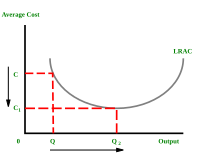
Photo from wikipedia
Urban growth has evolved from cities to metropolitan areas and urban agglomerations, exhibiting a multi-scale pattern. Urban scaling law can reflect the nonlinear relationship between urban indicators and population size,… Click to show full abstract
Urban growth has evolved from cities to metropolitan areas and urban agglomerations, exhibiting a multi-scale pattern. Urban scaling law can reflect the nonlinear relationship between urban indicators and population size, which is very important for urban planning through analyzing the evolution of urban system characteristics. However, existing studies mainly focused on scalar law within countries, neglecting the multi-scale synergistic evolution of complex urban systems. The purpose of this study is to investigate the scalar relationship between urban indicators and population size at multiple scales from the perspective of individual cities, metropolitan areas, and urban agglomerations, using data from 45 cities in three urban agglomerations in eastern China. Based on the urban scaling law, local spatial autocorrelation model is used to analyze and explore the collaborative evolution of multiple scales. Results show that from the perspective of time evolution, the three urban agglomerations exhibit greater scaling effects than metropolitan areas, with a scaling exponent (β) greater than 1 for urban indicators including economy, land, infrastructure, ecological pressure, and innovation. From the perspective of spatial differences, the spatial development gap between the metropolitan area scale and the urban agglomeration scale is relatively small compared with the city scale. In addition, the Beijing–Tianjin–Hebei urban agglomeration (BTH) mainly displays the synergistic development of the dual-core structure of Beijing and Tianjin. The Yangtze River Delta (YRD) exhibits significant disparities between its cities, resulting in a low degree of overall synergy. In contrast, the Guangdong-Hong Kong-Macao Greater Bay Area (GBA) leads in terms of synergistic evolution. This study is crucial to help understand the development of urban systems at different scales and to support regional planning and the achievement of coordinated development.
Journal Title: Buildings
Year Published: 2023
Link to full text (if available)
Share on Social Media: Sign Up to like & get
recommendations!